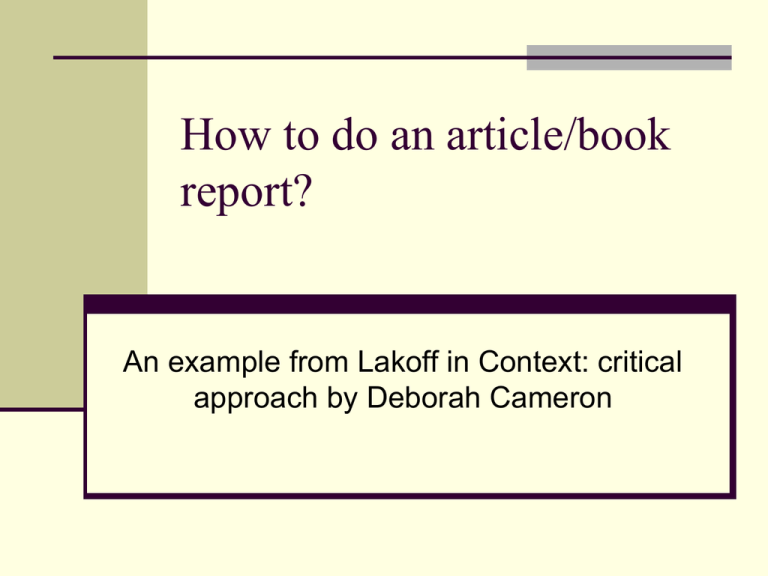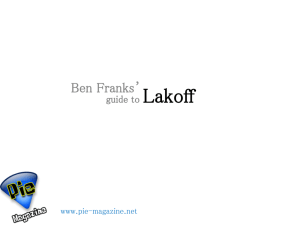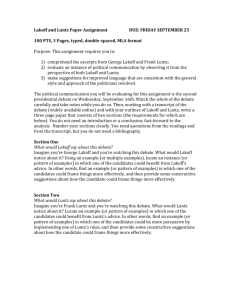
How to do an article/book
report?
An example from Lakoff in Context: critical
approach by Deborah Cameron
The basic elements in your report
What do you choose?
Why do you choose this work? Its relation to
the course and to what you want to do for the
final presentation.
Summarize the main points in the chosen
work.
How would these help your project and our
understanding of the topic.
Others
Lakoff in Context (the tag questions)
Why choose this article?
We have discussed the characteristics of
women’s speech from Lakoff (1975).
Many of you are interested in applying those
features to your research projects.
A rich literature on gender studies also use
Lakoff (1975) as a reference point.
Lakoff (1975) hypothesis?
Women’s language and why they speak
these way.
Women tend to use hesitation, intensifiers,
qualifiers, tag questions, rising intonations on
declarative, trivial lexical items and empty
adjectives.
They do so because of the lack of confidence,
awareness of their inferior social status as
well as show of deference/politeness for
others.
Cameron’s critical approach
Urge future investigators to be aware of the
complexity of relations between linguistic
form, communicative function, social
context and social structure (p. 74).
Use tag questions as examples for
contentions.
Lakoff’s claim of tag question usage
What are the contentions?
Lakoff equates rising intonation on
declaratives with showing tentativeness; tag
questions are associated with a desire for
confirmation or approval which signals a lack
of self-confidence in the speaker. Qualifiers
and intensifiers function in discourse as
hedges.
Types of tag questions
It’s a nice day.
It’s a nice day, isn’t it? (+ tag, less assertive)
I don’t really want it. (+qualifier, less
assertive)
I don’t want it.
What’s wrong?
According to Lakoff (1975), a speaker who uses these
mitigating features frequently will appear weak,
unassertive and lacking in authority. From her claim
that features are typical of women’s speech it follows
that women appear weak and unassertive (p. 76).
….Studies taking their cue from LWP have too often
been preoccupied with its empirical dimension (do
women use more of features x, y, and z?) to the
exclusion of crucial underlying problems.
Two problems need to be discussed
The form and function problem
That was a silly thing to do, wasn’t it (parent to child). (p.77)
Problem with explanations
Lakoff relates unassertive female speech to the norms of
femininity which follow in turn from women’s subordinate social
position.
Whether gender role (femininity) and status (defined in terms
of a cluster of features like age, social class, sex, position in
occupational and other hierarchies) should be conflated.
If not, whether one is more important than the other in
determining or influencing an individual’s speech style.
Put crudely, is “women’s language” a consequence of being
female, or of being subordinate, or some mixture of the two?
Holmes’s approach to tag questions
Holmes suggests 1984:50
At least two interrelated contextual factors
need to be taken into account, namely the
function of the speech act in the developing
discourse, and the relationship between the
participants in the context of utterance (p.
82).
Tag questions again from Holmes’
Modal tags are those which request information or
confirmation of information of which the speaker is
uncertain; in Holmes’s terms they are ‘speakeroriented’, i.e. designed to meet the speaker’s need
for information.
You were missing last week/ weren’t you?
But you’ve been in Reading long than that/ haven’t
you?
The other type of tag question
Affective tags by contrast are addressee-oriented.
They are used not to signal uncertainty on the part of
the speaker, but to indicate concern for the address.
This concern can take two distinct forms.
It can exemplify what Brown and Levinson (1978) call
‘negative politeness’: a speaker may use a tag to
‘soften’ or mitigate a face-threatening act.
Open the door for me, could you?
The other type of tag questions
(Cont.)
The other type is the facilitative tag:
His portraits are quite static by comparison,
aren’t they?
Quite a nice room to sit in actually, isn’t it.
It is precisely the ‘facilitative’ tag which
Lakoff would read as ‘illegitimate’, a
covert request for approval.
Conclusion
Firstly, the relation between linguistic form and
communicative function is not a simple thing.
We cannot state a priori what tag questions do, even
using something like Holmes’s modal/affective
distinction.
This should make future researchers rather wary of
the line of argument popularized by Lakoff, that if
women use form x more than men.
we should seek an explanation of this in terms of the
invariant communicative function of x.
Conclusion (cont.)
Secondly, our findings suggest that the patterning of
particular linguistic forms may be illuminated by a
number of variables, not just gender.
This includes the role taken by participants in
interaction, the objectives of interaction, participants’
relative status on a number of dimensions and so on.
‘women’ do not form a homogeneous social group.
Gender is cross-cut with other social divisions and
their relative importance is affected by the specifics of
the situation (for instance, in a courtroom or
classroom occupational role is likely to be more
salient than any other social variable).











